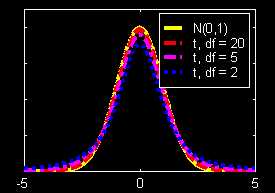
The t-distribution, and using Excel to calculate t probabilities.
First look at how the t distribution compares to the Standard Normal distribution:

These are probability density curves. Remarks:
- The t densities also have a mound shape, fairly similar
to the normal.
- They are all "more spread", and the spreading is more
for larger degrees of freedom.
- The "small probability cutoffs" will be much farther
out
for smaller degrees of freedom.
- The t curves converge to the Normal curve as the
degrees of freedom goes to infinity.
The main idea is to use Insert ---> Function ---> TDIST
(e.g. in the "Statistical" section of the "Paste Function" menu, or alternatively get to here using the "f sub x" button) as a replacement for NORMDIST;.
Similarly use TINV in place of NORMINV.
The big picture organization of these is:
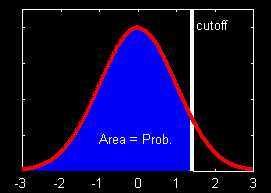
These functions allow conversion between cutoff and Area as:
1. To get Area, from a given cutoff, use:
Area = NORMDIST(cutoff, [& other params])
Area = TDIST(cutoff, [& other params])
2. To get cutoff from a given "Area", use:
cutoff = NORMINV(Area, [& other params])
cutoff = TINV(Area, [& other params])
Eg 14.1: For T ~ t(15), i.e, "T has a Student's t distribution, with n degrees of freedom", find P{T < 1.41}.
This problem is of the type 1 above.
Use the above steps to arrive at the TDIST menu. Fill out the
menu as usual, using either typed in numbers, or references to cells, to
get:
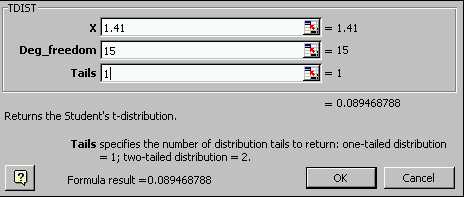
Notes:
- the cutoff here is "x", set to 1.41.
- the degrees of freedom (reflecting variability in s)
is set to 15.
- the "tails" parameter is new. Set this to one,
since we don't want both tails here.
- the final probability is 0.0895.
CAREFUL: that
final probability is way off. Here is the picture of what we are
after:
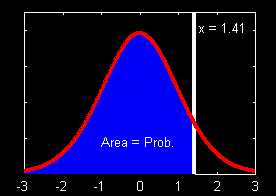
This probability is clearly much bigger than 0.5 (in contrast to the
above answer of ~0.09).
The lesson is that TDIST works in a different way from NORMDIST.
In particular, it works with tails of the distribution. So
to calculate this probability, the "1 -" approach needs to be used. Here
is the resulting spreadsheet with the correct answer:
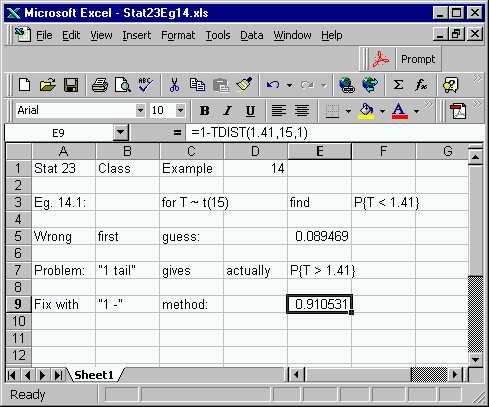
Notes:
- this answer is much more sensible
- the formula bar shows how to work with this by just
typing in a formula
(this skill will be needed for the midterm).
- the corresponding Standard Normal probability, P{Z
< 1.41} = 0.921
is rather close, and larger (as expected from above pic)
Eg 14.2: For T ~ t(5), find P{0.02 < T < 1.41}.
This is done using the same idea as for Normals:
P{0.02 < T < 1.41} = P{0.02
< T} - P{1.41 < T} =
= "=TDIST(0.02,5,1) - TDIST(1.41,5,1)"
= 0.384
Notes:
- the probabilities "go the
other way", because of the "tail" aspect of TDIST.
- Once again this is close to the
corresponding N(0,1) version:
P{0.02 < Z < 1.41} = 0.413
but the gap is bigger this time, since the degrees of freedom is smaller
(thus farther from the Standard Normal)
Eg 14.3: For T ~ t(60), find P{|T| < 1.96}.
Recall that this can also be written as:
P{|T|
< 1.96} = P{-1.96 < T < 1.96}
The picture for this one is:
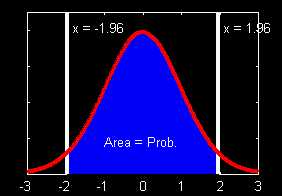
Here is where the "2-tail" option of TDIST is really useful. Instead of the serious fiddling with areas that is needed for NORMDIST, this is now much easier.
But recall that "tails" means "the outside part", so use the "1 -" trick:
P{|T|
< 1.96} = 1 - P{|T| > 1.96}
= 1 - TDIST(1.96,60,2)
= 0.945
Again it is interesting to compare to the Normal. For this large
degrees of freedom, expect close answers, and indeed get:
P{|Z|
< 1.96}= 0.950
Eg 14.4: For T ~ t(13), find c so that P{|T| > c} = 0.10.
Note that this is now a problem of the type 2, in the general setup above, so use TINV.
The TINV menu, appropriately filled out is:
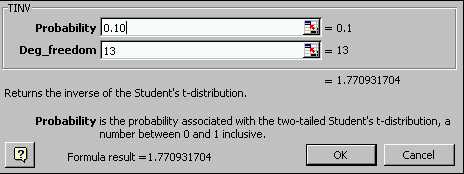
Notes:
- Here one must use the 2-tailed version, (there
is no one tailed option).
- The answer is once again close to (and as expected slightly
larger than)
the Standard Normal answer: 1.64
Eg 14.5: For T ~ t(7), find c so that P{T > c} = 0.10.
This one is harder than the above, since TINV works only in two tailed
terms. The trick is to rewrite the problem in terms of a 2 tailed
probability:
P{|T| > c} = P{T < -c
or c < T} =
= P{T < -c} + P{c < T} =
(since events are disjoint)
= P{T > c} + P{T > c} =
(using symmetry of the t dist.)
= 2 * P{T > c}
Thus want to find c so that:
P{|T| > c} = 0.20
Get this by: TINV(0.2,7) = 1.41
The final result of all the work done here is available on the spread
sheet version of this example.
Back to Stat 23 Home Page
Back to Marron's
Home Page